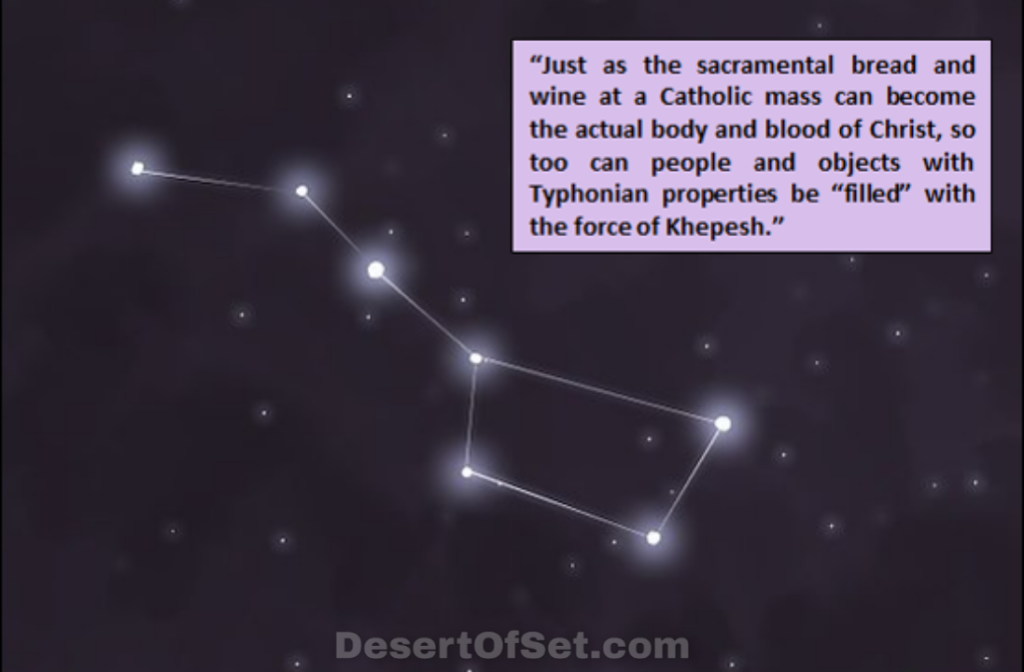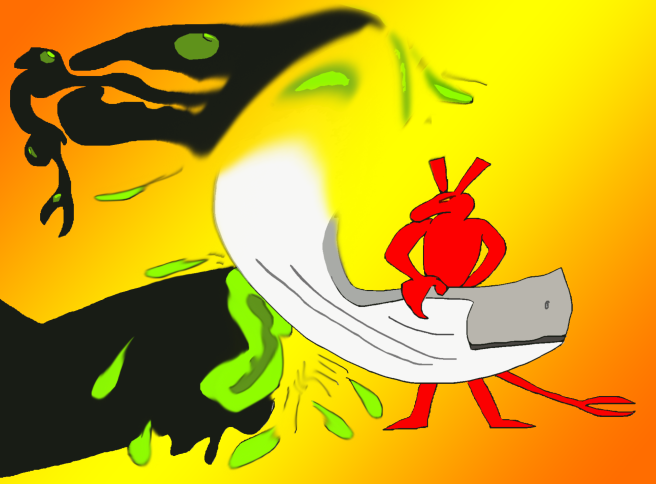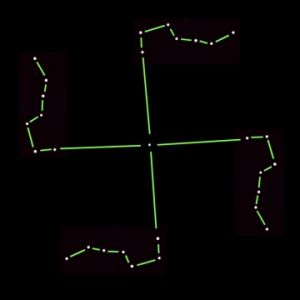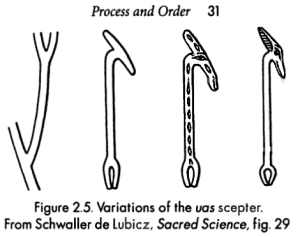Explaining Set’s connections to the Big Dipper, and why they are important.

In Egyptian mythology, Khepesh (“The Thigh”) is the Iron of Set. This powerful force was once a part of Set Himself, but it was removed from Him by Horus during Their war for the throne of civilization. It is sometimes described as being Set’s “bone,” “foreleg,” “semen,” or even His “testicles” (which means its removal is sometimes described as a “castration”). This Iron is what enabled Set to kill Osiris, and it was returned to Him once He was “tamed” enough to be reconciled with the rest of the Gods. Set now uses Khepesh to defend Ra from the Chaos Serpent, and its physical counterparts in nature include the asterism we know today as the Big Dipper, as well as the chemical element Fe (iron).
Khepesh is often contrasted with Wedjat, the Eye of Horus (or “All-Seeing Eye”), which Set removed from Horus during Their fight. We use our eyes to see things, which is why Wedjat is associated with light, knowledge, and order; it represents “shedding light” on the unknown and making it known. Khepesh, on the other hand, is linked to Set’s libido; it represents the unknown’s ability to intrude upon the known and force it to adapt. Despite this disruption, Khepesh is an altogether different kind of “chaos” from that of the Chaos Serpent, for it doesn’t threaten to destroy everything in Creation; it simply destroys certain things to make room for others. Hence why it is the perfect weapon against the Serpent, and in this respect it is often portrayed in Egyptian art as a lance or spear that Set carries into battle.

The Iron of Set is comparable to other monster-slaying weapons in mythology, such as Mjollnir (Thor’s hammer). Both are associated with red-haired storm deities; both must remain externalized from their users (for even Thor must wear gloves while handling Mjollnir); and both have strong phallic connotations (as when Mjollnir is placed on the bride’s lap during Nordic wedding ceremonies). We may further compare Khepesh to Thurisaz, the third rune in the Elder Futhark, which represents how the destructive powers of nature can be used for protective purposes. The word Khepesh was additionally used for a sword the ancient Egyptians carried in battle, and which is shaped like the Big Dipper.

An Egyptian khepesh sickle-sword.
Khepesh was “tethered” to the star Polaris (our planet’s current north pole star) by the Goddess Taweret to keep it as far away from Osiris as possible. It’s also kept there as a kind of “cosmic scarecrow” to prevent the Chaos Serpent from attacking our world through the northern sky. In the Greek magical papyri, Set is said to live somewhere “behind” the Big Dipper, in a “Secret Place” that none of the other Gods can reach. This realm has been linked with the Hermetic concept of Daath on the Tree of Life, and it is sometimes called “the Mauve Zone” or “the Desert of Set.” That last term is taken from how the Egyptians considered their country to be the very pinnacle of human civilization. The deserts surrounding Egypt (called Deshret or “the Red Lands”) were viewed as protecting it from “the world outside”; hence this notion that Set roams the chaotic maelstrom “out there” to keep the created world safe “in here.”
From an animist perspective, everything about the Big Dipper may be seen as an astral reflection of Khepesh. Bearing this principle in mind, we can make the following observations about Set’s Iron:
- Most of the Egyptian Gods are linked to stellar objects that “fall beneath” and “rise above” the horizon, including the Sun, the Moon, Sirius, and constellations like Orion. These deities are reported to “die” and “rise again” (or to accompany other dying-and-rising Gods through their transitions). But the Big Dipper is circumpolar and never sets, representing Set’s inability to ever die. While the other Gods experience a cyclical kind of immortality, Set’s is continuous and linear. Khepesh is what gives Him the immense strength He needs to be truly deathless.
- Since the Dipper points north, it makes a perfect “cosmic compass” and has been used as such for centuries. For the ancient desert peoples who worshiped Him, it must have seemed like Set was faithfully guiding them through the night whenever they were lost. This indicates that Khepesh, no matter how destructive or frightening it might be, is actually a force for good in this world, as well as its last line of defense from the Serpent and its qliphoth.
- The Dipper rotates counterclockwise (to the left), and leftness has always been linked with asymmetry, inversion, and reversal (whether social, political, or spiritual). So Khepesh is tied to Set’s anti-establishment sensibilities, which explains His popularity among left-hand path occultists.
- The Dipper forms a giant swastika in the northern sky. This is actually a symbol for prosperity and good luck in many cultures; it doesn’t “belong” to National Socialists anymore than crosses “belong” to the Ku Klux Klan. But that doesn’t change the fact that most Westerners react badly to the swastika for reasons that are completely understandable. This relates to Set’s reputation as a so-called “evil” God. Just as He really represents something good but is mistaken for being “evil” by outsiders, so too does the swastika represent something good in religions like Hinduism and Buddhism, despite being tied to Nazism in the West. Part of being Setian, in my opinion, involves being able to understand this kind of nuance, which is not easy for most people to do.

That Khepesh is linked to iron (Fe) is also interesting, given that this chemical element has traditionally been used to ward off malevolent daemons, faeries, witches, and the Evil Eye. Prison bars were once made from iron to restrict any negative energy that might be emanating from the most dangerous prisoners. Even today, Bedouins still believe that a person who fights with a sword forged from meteoric iron will win any battle. It’s a little spooky that the Greek philosopher Pythagoras claimed that Typhon’s number is 56, considering that the atomic weight of iron is 55.845 (which rounds up to 56). Nor is it a coincidence that iron should be linked to the color red, the planet Mars, or the Qabalic sphere of Geburah.
In the Ceremony of the Opening of the Mouth, Khepesh was invoked into an adze or chisel that had been forged from meteoric iron, and which was shaped to resemble the Big Dipper. This adze was then pressed against the mouth of a mummy or statue while the priests recited spells invoking “the iron that comes forth from Set.” Doing this effectively transformed the inanimate object into a living conduit for a deity or the ghost of a deceased loved one. The principle behind such ritual magic is more or less identical to that of Catholic transubstantiation. Prior to Mass, the communal bread and wine are merely foodstuffs; they don’t become the mystical body and blood of Christ until all the magic words have been properly recited. In the same way, an Egyptian cult image started its existence as merely an image; it would not “come alive” with the spirit of the God or ghost it was meant to represent until after its mouth had been symbolically “opened.” Interesting that Khepesh, the same power Set uses to stomp Osiris and smite the Serpent, can also be used to create magical interfaces between this world and the next.

Horus “opening the mouth” of a mummy.
Khepesh is additionally connected to the was scepter, which bears the head and forked tail of the Sha animal. The name was (which rhymes with “Oz”) means “power” or “dominion,” and the scepter represents the royal power to sublimate chaos. Using the Sha in this symbolism is similar to the use of stone gargoyles in Christian churches. The gargoyles represent dark, chaotic forces that have been “domesticated” and which now protect us from other forces that are even worse. This reminds me of the parallels between Set and Tokyo’s favorite giant monster, Godzilla. Both begin innocently enough, but later become extremely dangerous beings that threaten to destroy the whole world. Then both are eventually “reigned in” to defend the Earth from evil hell monsters like Apep and King Ghidorah.

As a final thought, Khepesh is similar in concept to what Christians call “the Blood of Christ.” The latter is supposedly a real mystical substance that washes away all sin from a person’s heart. Likewise, Set’s Iron “straightens the spines” and “opens the mouths” of both the Gods and the dead. Both objects are formerly part of a deity’s body, and both can be magically “drawn down” by worshipers into physical devices. Just as the sacramental bread and wine at a Catholic mass can become the actual body and blood of Christ, so too can people and objects with Typhonian properties be “filled” with the force of Khepesh.
References
Alford, A. F. (2003). Pyramid of secrets: The architecture of the Great Pyramid reconsidered in the light of creational mythology. Walsall, England: Eridu Books.
Almond, J., & Seddon, K. (2004). Egyptian Paganism for beginners. St. Paul, MN: Llewellyn.
Assante, M. K., & Mazama, A. (Eds.) (2009). Encyclopedia of African religion, volume 1. Thousand Oaks, CA: SAGE Publications, Inc.
Assman, J. (2002). The mind of Egypt: History and meaning in the time of the Pharaohs. Cambridge, MA: Harvard University Press.
Budge, E. A. W. (1934). From fetish to God in ancient Egypt. New York, NY: Dover.
Budge, E. A. W. (1904). The Gods of the Egyptians: Or, studies in Egyptian mythology (volume 2). London, UK: Methuen & Co.
Eliade, M. (1978). The forge and the crucible: The origins and structure of alchemy. Chicago, IL: The University of Chicago Press.
Friedman, D. M. (2001). Mind of its own: A cultural history of the penis. New York, NY: The Free Press.
Guiley, R. (2006). The encyclopedia of magic and alchemy. New York, NY: Facts on File, Inc.
Isler, M. (2001). Sticks, stones and shadows: Building the Egyptian pyramids. Norman, OK: University of Oklahoma Press.
Penprase, B. E. (2011). The power of stars: How celestial observations have shaped civilization. New York, NY: Springer.
Pinch, G. (2002). Egyptian mythology: A guide to the Gods, Goddesses, and traditions of ancient Egypt. New York, NY: Oxford University Press.
Roberts, M. J. (1994). Norse Gods and heroes. New York, NY: Friedman Group.
Seeds, M. A., & Backman, D. E. (2011). The solar system. Boston, MA: Brooks/Cole.
Simon. (2006). The gates of the Necronomicon. New York, NY: Avon.
Teeter, E. (2011). Religion and ritual in ancient Egypt. New York, NY: Cambridge University Press.
Te Velde, H. (1977). Seth, God of confusion: A study of His role in Egyptian mythology and religion. Leiden: E. J. Brill.
